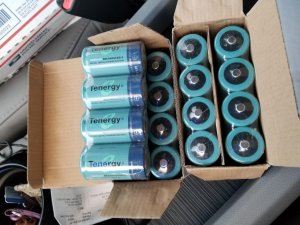Well, the flashlight was sold under the Duracell name and came pre-packaged with 4-duracell batteries. So are you starting to see it a bit more clearly now? It was designed specifically for their batteries I am guessing. Because the flashlight works perfectly and because all of the circuitry is hidden beneath some pressed in blocks of aluminum, there's no way to disassemble to see and know beforehand what type of circuitry it has. It's not that it doesn't have circuitry, it does. Otherwise it wouldn't have dimming, and flashing functions. Except that because the high draw nature of these new bulbs meant that the alkalines were unable to supply enough current due to it's own internal resistance to blow those LED's so they were unnecessary. Operated using their own cells, it's not a problem except for always buying disposable cells and costs have gone up quite a bit in recent times. Yes, I'm pissed that it blew, but this weekend, I'll go out and buy another. I'm not paying $600-$900 for a flashlight that includes circuitry to allow the flashlight to operate on all sorts of cells but $20 plus financing alkalines will be OK.Transistorized said:Sorry to hear about your flashlight Norm. Despite its failure I'm sure from a technical standpoint (despite being diappointed) you would agree with me in that it sounds like a poor decision and cost cutting at it's finest when they made that flashlight. Didnt want to invest in a simple limiting circuit.
Very poor decision IMO because it makes sense that someone would use rechargeables in a flashlight.
Assuming someone might not is kind of ignorant on the company that made it. For the same reason a manufacturer decides to not put diodes in circuit to prevent reverse polarity damage. Yes you can save money and not...but should you....yes.
Anyhow, I've hijacked Chris' thread about NiMH and boomboxes. So going back to current ability and boomboxes... all boomboxes have amplifier circuits that are powered by an unregulated power supply. This allows the boombox to operate under a wide range of voltages. The 19.5 volts that you get from AC on a 15v boombox? That's with no load. As soon as you crank it, the voltage drops. So under heavy use, suffice to say that the voltage supply will be constantly fluctuating with load and bass hits. But with NiMH, even with the slightly lower voltage which boomboxes generally have no problem with, the higher current delivery ability of these cells means that the supply will be very steady and stable. I recall a story about one of the Florida sunshine mixes, that one fella with an Aiwa 880 was killing the other boomboxes. It's secret? Not AC, but Rechargeable batteries. Their low internal resistance allows them to deliver the goods when alkaline cells wimp out during high current demands.








